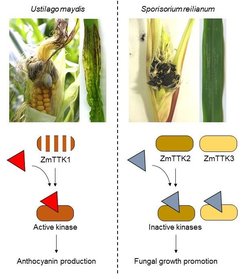Corn smut has undergone a specialized evolution for virulence
Smut fungi are pathogens that parasitize mainly grass plants including economically important cereals like maize. Most smut pathogens cause disease symptoms only in the flowers of their host plants. An exception is Ustilago maydis, a fungus inducing tumor formation and anthocyanin accumulation in all above ground organs of maize (Figure 1). Anthocyanin formation allows the fungus to spread efficiently in the infected tissue. It is unclear how U. maydis has acquired such a unique pathogenic lifestyle.
Scientists from the Max Planck Institute for Terrestrial Microbiology in Marburg have now shown that a secreted effector protein from U. maydis has evolved to have a unique function. Their finding provides novel insights into the evolution of pathogen effectors.

U. maydis secretes several hundred effector proteins, which suppress plant defense responses and modulate plant metabolism to benefitthe fungus. The Tin2 effector of U. maydis induces anthocyanin accumulation in maize through the stabilization of the maize protein kinase ZmTTK1 (Figure 1). S. reilianum encodes a Tin2-related protein but S. reilianum is unable to induce anthocyanin accumulation. Tanaka et al. now show that Tin2 of S. reilianum targets ZmTTK2 and ZmTTK3, two kinases related to ZmTTK1. Through this interaction, the kinase activity of both kinases is inhibited and this results in the promotion of fungal growth. Tanaka et al. have also reconstructed an ancestral Tin2 gene and show that its function is similar to the function of S. reilianum Tin2 rather than to Tin2 of U. maydis. This illustrates that Tin2 of U. maydis has acquired a specialized function during evolution. Tanaka et al. propose that the neofunctionalization of the Tin2 effector protein of U. maydis is a key evolutionary event that has contributed to the unique disease symptoms caused by U. maydis.





![<p>Discovery of [Fe]-hydrogenase in bacteria opens new possibilities for conversion of hydrogen</p>](/506336/original-1555497672.jpg?t=eyJ3aWR0aCI6MzYwLCJoZWlnaHQiOjI0MCwiZml0IjoiY3JvcCIsImZpbGVfZXh0ZW5zaW9uIjoianBnIiwib2JqX2lkIjo1MDYzMzZ9--d3d7c57e064104c2acc573916156127d6bedd85b)

![Protection of [Fe]-hydrogenase](/416905/teaser-1561027823.jpg?t=eyJ3aWR0aCI6MzYwLCJoZWlnaHQiOjI0MCwiZml0IjoiY3JvcCIsImZpbGVfZXh0ZW5zaW9uIjoianBnIiwib2JqX2lkIjo0MTY5MDV9--6ea496a03c86ba3d98a19e05aac63809917fe800)




